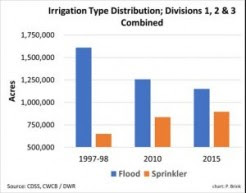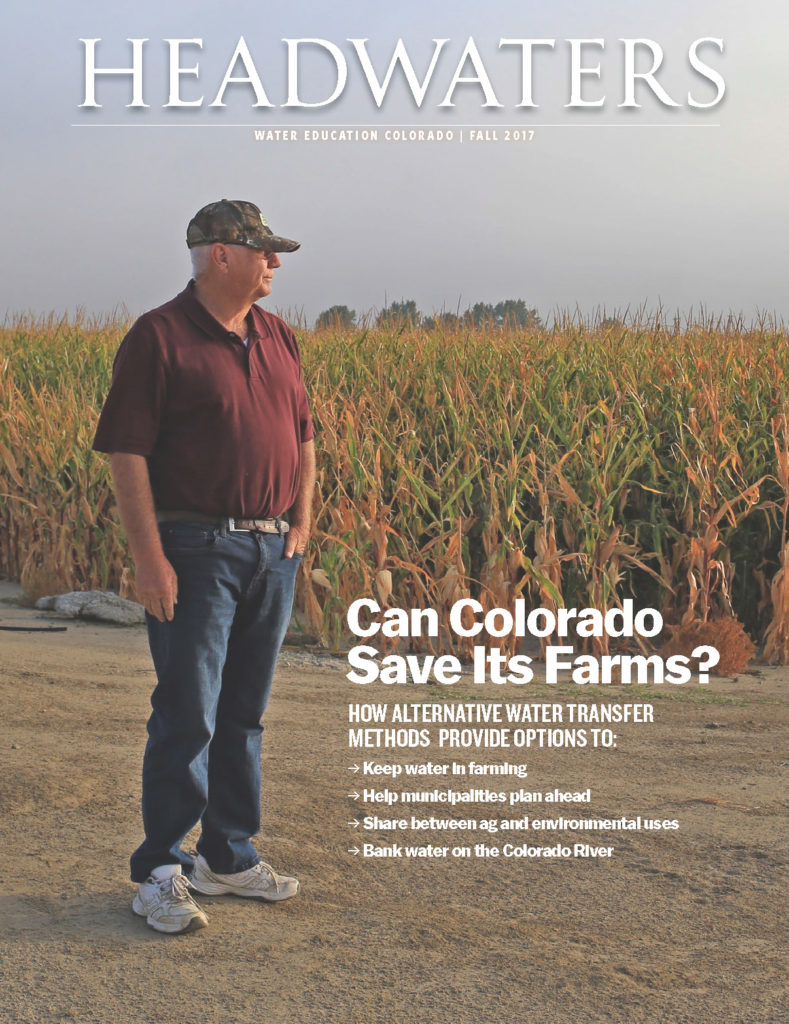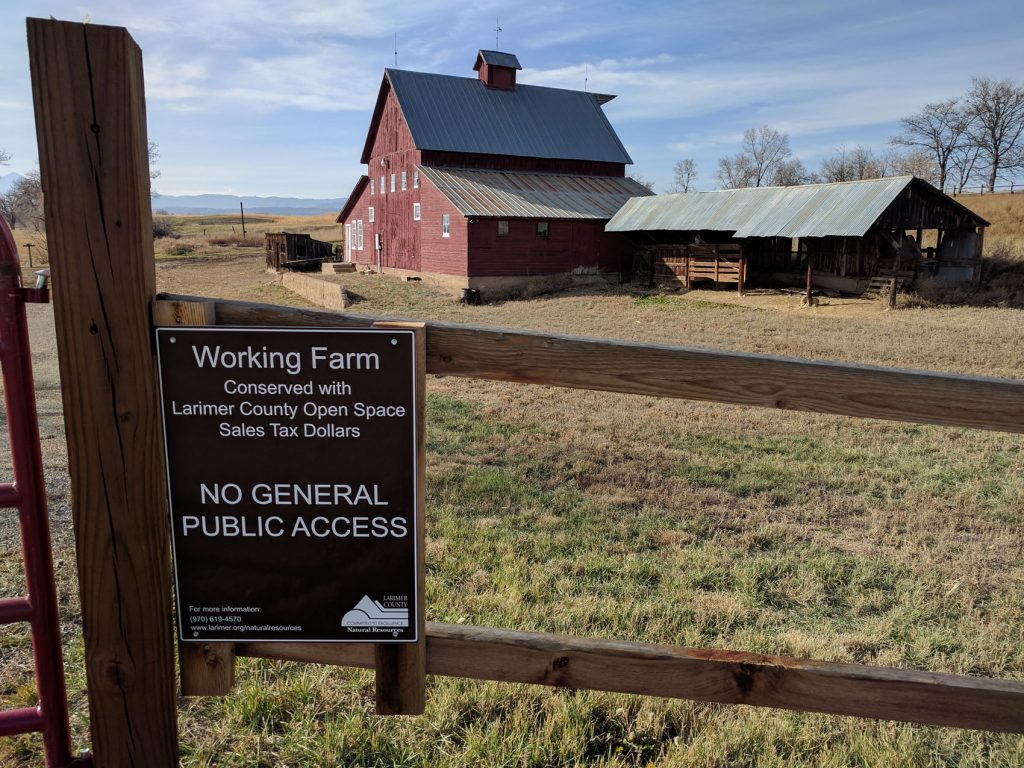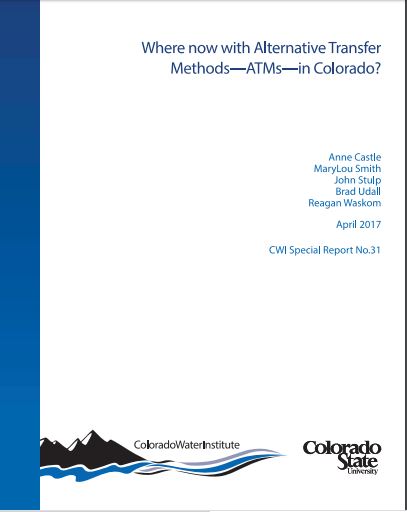We’ve been sending a weekly “Six Feet in Solidarity” email on Thursdays to keep you company. Our hope is to stay connected and continue serving up resources to build your water knowledge around different topics for as long as social distancing lasts.
We’re already almost through week five of social distancing, which means we’ve been pulling from our library of publications, news stories, webinars, videos, radio programs, and more, and also sharing key resources produced by others in the water community for five weeks.
Thus far we’ve sent emails focused on land use and water, stream management plans in Colorado, environmental justice and equity in the water sector, and water reuse. This week we’ll look at alternative transfer methods and the value of agriculture. Read on to learn more. And continue to be well!
Can Colorado Save its Farms?

Gerry Knapp, who supervises Aurora’s operations in the Lower Arkansas Valley, looks over rows of onions at Mameda Farms in Rocky Ford. The farm is drip irrigated as part of Aurora’s Continued Farming Project.
Colorado has been growing, adding 100,000 residents annually. Most new residents live along the Front Range, home to 84 percent of Coloradans in 2015, according to state Department of Local Affairs estimates. It’s all premised on water. Fields across the state have dried, the result of cities buying farms for their water rights, a practice called buy and dry.
Cities have gone to farms because that’s where the water is: Agriculture accounts for 86 percent of total water diversions in Colorado, according to the Colorado Division of Water Resources. Buy and dry has remained attractive to water managers responsible for ensuring municipal water supplies as the state’s population pushes forward. Farmers tend to hold the most senior—and most secure—rights.
By 2050, Colorado could lose 146,000 to 334,000 acres of currently irrigated farmland due to water transfers to meet municipal growth demands, according to the Analysis and Technical Update to the Colorado Water Plan’s Volume 2 Section 3: Current and 2050 Planning Scenario Agricultural Diversion Demand section.
Can we do better? Can we grow towns and cities and also corn and hay?

Mark Harris with the Grand Valley Water users Association stands above the Government Highline Canal in the Grand Valley. This water is used to irrigate the farms that Water Asset Management has recently purchased. Photo by Greg Poschman.
Yes, arguably, we can. Innovative tools have been forged over the past several decades that seek to achieve this hydrological alchemy, where cities and farms grow side by side by sharing water, among them interruptible water supply agreements, split-season irrigation, and multiple-use decrees. The umbrella term used to describe such tools is ATMs, or alternative transfer methods.
Chapter 6.4 of Colorado’s Water Plan, focused on alternative agricultural transfers, calls for 50,000 acre-feet of water to be identified in ATMs by 2030. Projects from Larimer County to Grand Junction to Rocky Ford demonstrate that Colorado is looking for solutions. The answers matter, because you never know when the next big drought will arrive. Read about it in the story “Flex Time for Colorado Water” in the Fall 2017 issue of Headwaters magazine focused on ATMs.
How can Colorado reach its goal and scale up the adoption of alternative transfer methods?
 In January 2018, WEco offered a webinar exploring this question. How will Colorado meet the goal set forth in the water plan of 50,000 acre-feet identified in ATMs by 2030? Experts Kevin Rein, Colorado’s State Engineer; Peter Nichols, special counsel to the Lower Arkansas Valley Water Conservancy District and to the Lower Arkansas Valley Super Ditch Co.; and Jim Yahn, manager of the North Sterling Irrigation District discuss, with conversations around existing policy and policy changes that might increase the adoption of ATMs. Watch it here.
In January 2018, WEco offered a webinar exploring this question. How will Colorado meet the goal set forth in the water plan of 50,000 acre-feet identified in ATMs by 2030? Experts Kevin Rein, Colorado’s State Engineer; Peter Nichols, special counsel to the Lower Arkansas Valley Water Conservancy District and to the Lower Arkansas Valley Super Ditch Co.; and Jim Yahn, manager of the North Sterling Irrigation District discuss, with conversations around existing policy and policy changes that might increase the adoption of ATMs. Watch it here.
Letter: Colorado needs its ag water
In March 2020, this letter to the editor by Greg Peterson and Phil Brink, published in Fresh Water News, explained the differences between ag water efficiency and conservation, the importance of irrigated agriculture, ATMs and more. Read excerpts below:
It takes a lot of water to grow food – but the amount that ends up in the food itself is a small part of the story. According to Colorado State University (CSU), more than 99 percent of the water used by irrigated crops or turf is drawn through the roots and transpired through the leaves. Only about a tenth of one percent (0.1%) of the water taken up by plants is used to produce plant tissue. Crops use a lot of water to conduct photosynthesis and manage heat stress … Given the realities of plant evapotranspiration rates, it is not surprising current crop consumptive use remains on par with historic consumptive use even though many acres have been equipped with more efficient irrigation systems.
 Using less water on farms either means ‘buy and dry’ – which results in the permanent loss of irrigated farmland – or a temporary measure that reduces farm water consumptive use. The three water use reduction measures – or ‘alternative transfer mechanisms’ – being discussed in Colorado are rotational fallowing, crop switching and deficit irrigation.
Using less water on farms either means ‘buy and dry’ – which results in the permanent loss of irrigated farmland – or a temporary measure that reduces farm water consumptive use. The three water use reduction measures – or ‘alternative transfer mechanisms’ – being discussed in Colorado are rotational fallowing, crop switching and deficit irrigation.
More Resources from WEco on ATMs
Headwaters magazine: The ATMs issue
 This issue explores alternative transfer methods or ATMs, a term used to describe water sharing and banking projects. ATMs could provide flexibility for stretched water supplies, but not without marked changes. Read the Fall 2017 issue here.
This issue explores alternative transfer methods or ATMs, a term used to describe water sharing and banking projects. ATMs could provide flexibility for stretched water supplies, but not without marked changes. Read the Fall 2017 issue here.
ATMs a solution to Colorado’s water crisis?
 ATMs are typically temporary leases, but as part of our ongoing radio series, Connecting the Drops, a landmark deal sees one of these alternative transfer methods happen in perpetuity. Listen to the story here.
ATMs are typically temporary leases, but as part of our ongoing radio series, Connecting the Drops, a landmark deal sees one of these alternative transfer methods happen in perpetuity. Listen to the story here.
More Resources from Other Organizations
A guide for local leaders in Colorado from Waternow Alliance
 WaterNow Alliance presents this guide to farm-friendly water transfers for Colorado municipal water leaders. Read it here.
WaterNow Alliance presents this guide to farm-friendly water transfers for Colorado municipal water leaders. Read it here.
ATMs from Colorado Water
 Read the January/February 2018 issue of Colorado Water from the Colorado Water Center at Colorado State University for more on this approach toward balancing municipal and agricultural water needs. Find it here.
Read the January/February 2018 issue of Colorado Water from the Colorado Water Center at Colorado State University for more on this approach toward balancing municipal and agricultural water needs. Find it here.
Report: Where now with Alternative Transfer Methods in Colorado?
 This 2017 report out of the Colorado Water Institute at Colorado State University is intended to provide a foundation upon which further progress toward meeting the Colorado Water Plan’s ATM goal can be built. Read it here.
This 2017 report out of the Colorado Water Institute at Colorado State University is intended to provide a foundation upon which further progress toward meeting the Colorado Water Plan’s ATM goal can be built. Read it here.
Volume 2 Section 11 of the Analysis and Technical Update to the water plan: ATMs
 This case study reviews select ATM projects that have been recently implemented while highlighting key characteristics of the ATM that provide insight into how future ATMs might also be successfully structured. Read it here.
This case study reviews select ATM projects that have been recently implemented while highlighting key characteristics of the ATM that provide insight into how future ATMs might also be successfully structured. Read it here.


 Print
Print